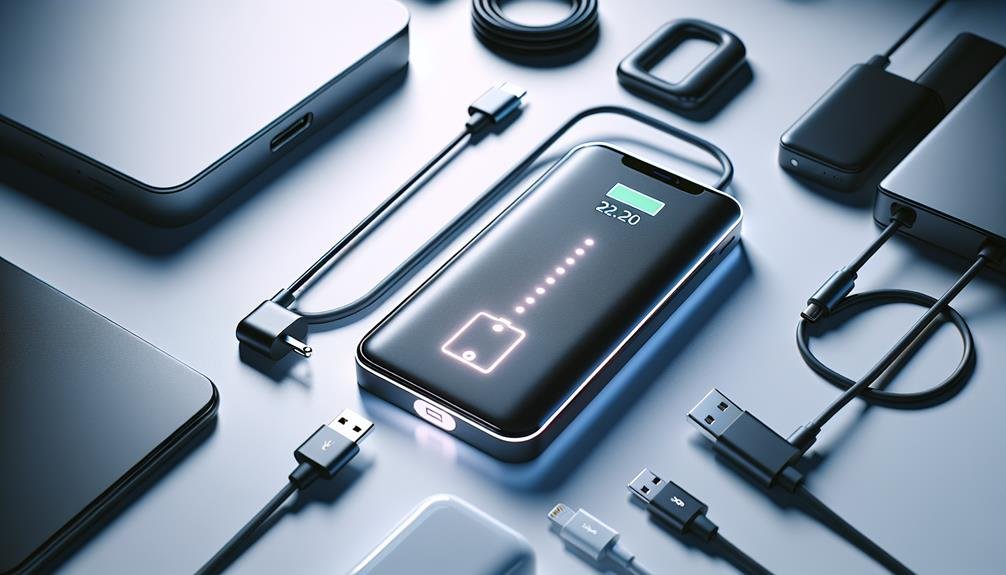A power bank is a portable device that lets you charge your electronic gadgets on the go. It's especially handy when you're out and about and your phone or tablet runs low on battery. Power banks come in various sizes, with battery capacities measured in milliamp-hours (mAh) that determine how many charges they can offer. They typically include USB ports for connecting your devices, indicator lights to show battery status, and safety features like overcharge protection. To choose the best one, consider capacity, charging speed, and compatibility with your devices. Want to find out which type suits your needs the best?
Definition of a Power Bank

A power bank, also known as a portable charger, is a compact, battery-powered device designed to recharge your electronic gadgets on the go. Think about those moments when your phone's battery dies at the most inconvenient times—whether you're traveling, at a conference, or simply out and about. That's where a power bank steps in, offering a convenient solution to keep your devices powered up.
One of the major portability benefits of power banks is their ease of carrying. They come in various sizes, from pocket-sized models to larger ones with more capacity, making sure you can always find one that fits your needs. The key aspect to take into account is battery capacity, usually measured in milliampere-hours (mAh). The higher the mAh, the more charges you can get out of a single power bank. For instance, a 10,000 mAh power bank can typically charge a smartphone two to three times.
Safety is paramount; always choose a power bank with built-in safety features like overcharge protection and short-circuit prevention. These features guarantee that both the power bank and your devices remain safe, allowing you to enjoy the benefits of portable power without worry.
Key Components
Understanding what makes a power bank reliable and efficient involves knowing its key components, from the battery cells to the circuit board. The battery cells, often lithium-ion or lithium-polymer, are the heart of the power bank. They determine the battery capacity, which is measured in milliamp-hours (mAh). A higher battery capacity means your power bank can store more energy, allowing you to charge your devices multiple times.
Charging ports are another essential component. Typically, these include USB-A, USB-C, or even Lightning ports. The number and type of charging ports affect how many devices you can charge simultaneously and at what speed. More ports and faster charging capabilities provide greater convenience and versatility.
Circuit protection is vital for safety. It includes features like overcharge, over-discharge, and short-circuit protection to ensure your devices and the power bank itself are safe during use. Without proper circuit protection, you risk damaging your gadgets or causing a fire hazard.
Lastly, indicator lights give you real-time information about the power bank's status. They let you know when it's fully charged, how much battery capacity is left, and if any issues arise. These lights add a layer of usability and safety, keeping you informed at all times.
Charging Mechanisms

Charging mechanisms in power banks are essential for determining how quickly and efficiently you can recharge both the power bank itself and your devices. The battery capacity of a power bank, typically measured in milliampere-hours (mAh), directly influences how many times it can recharge your devices. A higher battery capacity means more power stored, but it may also slightly affect portability due to increased size and weight.
Charging speed is another critical factor. Many modern power banks support fast charging technologies, allowing you to juice up your devices in a fraction of the time. Look for power banks with higher output ratings (measured in watts or amperes) for faster charging. However, make sure your devices are compatible with these higher outputs to avoid potential damage.
Safety features are paramount. Quality power banks come with safeguards like overcharge protection, short-circuit protection, and temperature control, ensuring safe operation. Always choose power banks from reputable brands to make certain they meet safety standards. Additionally, using the provided or recommended charging cable can prevent overheating and ensure peak performance.
Types of Power Banks
You'll find various types of power banks on the market, each designed to cater to different needs and preferences. Some power banks are compact and lightweight, making them ideal for those who prioritize portability and convenience. These typically have lower capacity options, usually between 5,000 to 10,000 mAh, perfect for emergency top-ups on the go.
For those needing more power, larger capacity options, such as 20,000 mAh or more, are available. These can charge your devices multiple times but are bulkier, which might make them less portable. Safety features like overcharge protection and short circuit prevention are essential, especially for higher-capacity models.
Wireless charging power banks are a modern choice, eliminating the need for cables and allowing you to charge compatible devices simply by placing them on the power bank. Fast charging technology is another critical feature, reducing the time it takes to charge your devices significantly. This can be a lifesaver when you're in a hurry.
Choosing the Right One

When selecting the appropriate power bank, it's vital to take into consideration factors like capacity, portability, charging speed, and additional features to match your specific needs. First, assess the capacity options. If you frequently use your devices on the go, opt for a higher capacity power bank, measured in milliampere-hours (mAh). A higher mAh means more charges for your devices.
Next, evaluate the design features and portability. Look for a power bank that's compact and lightweight if you plan to carry it around often. However, don't compromise durability for size—choose a robust design that can withstand everyday wear and tear.
Charging speed is another crucial factor. Power banks with higher output (measured in volts and amperes) can charge your devices faster. Check the port compatibility to guarantee it supports your devices' charging requirements. USB-C ports are becoming standard, but ensure it aligns with your device's needs.
Lastly, additional features like built-in cables, LED indicators, and safety mechanisms such as overcharge protection can be advantageous. Safety should always be a priority, so choose a power bank from a reputable brand to confirm it complies with safety standards.
Frequently Asked Questions
How Long Does a Power Bank Typically Last Before Needing Replacement?
A power bank's lifespan typically ranges from 2 to 3 years, depending on usage and care. Replacement frequency can vary, but you'll usually need a new one when its efficiency noticeably drops or safety features degrade.
Can Power Banks Be Taken on Airplanes?
Imagine a modern-day magic carpet for your devices. Yes, you can take power banks on airplanes, but watch travel restrictions. Airline policies often limit battery capacity to 100Wh. Check charging options to guarantee a smooth journey.
What Safety Features Should a Good Power Bank Have?
When selecting a power bank, you'll want safety features like overcharge protection and short circuit detection. Also, consider battery capacity and charging speed to guarantee efficient, safe charging for your devices. Your safety's paramount!
How Do You Properly Maintain a Power Bank?
Ever wondered how to extend your power bank's life? Start by adopting good charging habits. Store it in cool, dry conditions. Follow cleaning instructions carefully, and don't forget to check warranty coverage for added peace of mind.
Are There Any Risks Associated With Using Power Banks?
Yes, there are risks. Overcharging dangers can damage your power bank and device. Battery explosion risks, though rare, can occur if the power bank is faulty or improperly used. Always follow safety guidelines to minimize these risks.



